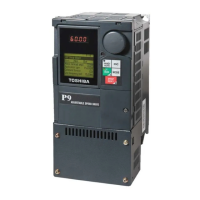P9 ASD Installation and Operation Manual 197
Low-Current Detection Threshold
Program Protection Low-Current Settings
When the Low-Current Trip (F610) parameter is enabled, this function sets
the low-current trip threshold.
The threshold value is entered as a percentage of the maximum rating of the
ASD.
Direct Access Number — F611
Parameter Type — Numerical
Factory Default — 0
Changeable During Run — Yes
Minimum — 0
Maximum — 100
Units — %
Low-Current Trip Threshold Time
Program Protection Low-current Settings
When the Low-Current Trip (F610) parameter is enabled, this function sets
the time that the low-current condition must exist to cause a trip.
Direct Access Number — F612
Parameter Type — Numerical
Factory Default — 0
Changeable During Run — Yes
Minimum — 0
Maximum — 255
Units — Seconds
Short Circuit Detection At Start
Program Protection Special Protection Parameters
This parameter determines when the system will perform an Output Short
Circuit test.
Note: Selection 3 is recommended for high-speed motor applications.
Because of the low impedance of high-speed motors, the
standard-pulse setting may result in a motor malfunction.
Settings:
0 — Every Start (Standard Pulse)
1 — Power On or Reset (Standard Pulse)
2 — Every Start (Short Pulse)
3 — Power On or Reset (Short Pulse)
Direct Access Number — F613
Parameter Type — Selection List
Factory Default — Every Start
(Standard Pulse)
Changeable During Run — No
Over-Torque Trip
Program Protection Over-Torque Parameters
This parameter Enables/Disables the Over-Torque Tripping function.
When enabled, the ASD trips if an output torque value greater than the setting
of
F616 or F617 exists for a time longer than the setting of F618.
When disabled, the ASD does not trip due to over-torque conditions.
Note: A discrete output terminal may be activated when an over-torque
alarm occurs if so configured (see
F130).
Settings:
0 — Disabled
1 — Enabled
Direct Access Number — F615
Parameter Type — Selection List
Factory Default — Disabled
Changeable During Run — Yes
F611 F615

